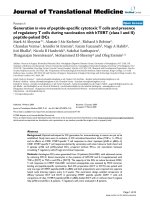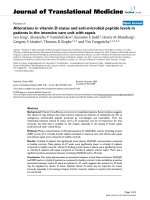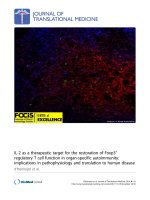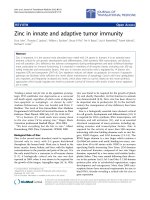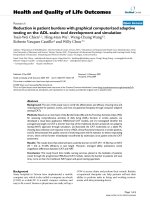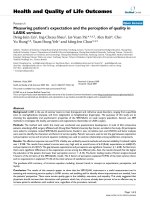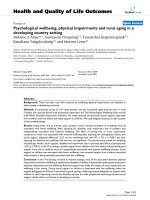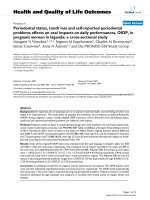Báo cáo hóa học: " Plasticity in neurological disorders and challenges for noninvasive brain stimulation (NBS)" pptx
Bạn đang xem bản rút gọn của tài liệu. Xem và tải ngay bản đầy đủ của tài liệu tại đây (245.45 KB, 5 trang )
BioMed Central
Page 1 of 5
(page number not for citation purposes)
Journal of NeuroEngineering and
Rehabilitation
Open Access
Review
Plasticity in neurological disorders and challenges for noninvasive
brain stimulation (NBS)
Gary W Thickbroom* and Frank L Mastaglia
Address: Centre for Neuromuscular and Neurological Disorders, University of Western Australia, Nedlands, Western Australia, Australia
Email: Gary W Thickbroom* - ; Frank L Mastaglia -
* Corresponding author
Abstract
There has been considerable interest in trialing NBS in a range of neurological conditions, and in
parallel the range of NBS techniques available continues to expand. Underpinning this is the idea
that NBS modulates neuroplasticity and that plasticity is an important contributor to functional
recovery after brain injury and to the pathophysiology of neurological disorders. However while
the evidence for neuroplasticity and its varied mechanisms is strong, the relationship to functional
outcome is less clear and the clinical indications remain to be determined. To be maximally
effective, the application of NBS techniques will need to be refined to take into account the
diversity of neurological symptoms, the fundamental differences between acute, longstanding and
chronic progressive disease processes, and the differential part played by functional and
dysfunctional plasticity in diseases of the brain and spinal cord.
Introduction
While there are a number of noninvasive brain stimula-
tion (NBS) techniques that can alter indices of brain excit-
ability, a lasting functional benefit from these
interventions in clinical populations remains elusive. Ini-
tially driven by psychiatric applications, and modeled on
the effectiveness of electro-convulsive therapy (ECT),
there is increasing interest in how neuromodulation by
noninvasive brain stimulation (NBS) might be extended
to neurological disorders. Underpinning this is the idea
that NBS modulates neuroplasticity and that plasticity is
important in the pathophysiology of neurological disor-
ders and plays an important role in functional recovery
and adaptation to neurological deficits. However while
the evidence for neuroplasticity and its underlying mech-
anisms is strong, the relationship to functional outcome is
less clear and somewhat theoretical. A re-appraisal of the
contribution of brain plasticity to the symptomatology
and functional outcome in neurological disorders may
help guide the clinical application of NBS, and is the topic
of this review.
What is brain plasticity?
The term plasticity as applied to the brain usually refers to
adaptability and reorganization, rather than large-scale
malleability (i.e. to 'software' rather than 'hardware' mod-
ifications). However in keeping with the original design
principle of plasticine, namely that it would not harden
(invented near Bath in 1897 by William Harbutt, early
samples have remained plastic for ~100 years), there is no
age limit in principle to the brain's adaptability or ability
to undergo plastic changes, only the degree and form vary
[1].
Brain plasticity may be neuronal or non-neuronal [e.g.
astrocyte-mediated; [2]], and neuronal plasticity in turn
Published: 17 February 2009
Journal of NeuroEngineering and Rehabilitation 2009, 6:4 doi:10.1186/1743-0003-6-4
Received: 4 November 2008
Accepted: 17 February 2009
This article is available from: />© 2009 Thickbroom and Mastaglia; licensee BioMed Central Ltd.
This is an Open Access article distributed under the terms of the Creative Commons Attribution License ( />),
which permits unrestricted use, distribution, and reproduction in any medium, provided the original work is properly cited.
Journal of NeuroEngineering and Rehabilitation 2009, 6:4 />Page 2 of 5
(page number not for citation purposes)
may be synaptic or non-synaptic [e.g. changes in intrinsic
excitability; [3]]. Given the fundamental importance of
synaptic transmission to brain function, it is the synapse
that incorporates the greatest range of mechanisms of
action and potential for plasticity (e.g. pre- and post-syn-
aptic, molecular and ionic, neurotransmitter dynamics,
receptor function and structure, retrograde messengers,
dendritic signaling; [see [4]]).
Synaptic plasticity may be further characterized according
to its spatial scale and mode of induction. Plasticity on an
intra-network scale can be thought of as a relatively-local-
ized change in synaptic weighting (or fine-scale synaptic
sprouting) within a functional neuronal unit such as a
neocortical column. Inter-network plasticity can be
thought of as a larger-scale remodeling (within or
between cerebral hemispheres) in the pattern of activity in
a network that serves a given brain function such as the
motor network, or even across functional networks, such
as recruitment of visual cortex during Braille reading in
the blind [5] or activation of auditory cortex during visual
stimulation in the deaf [6]. The most apparent clinical
manifestation is the increased activation reported in the
non-lesioned hemisphere after unilateral stroke [7]. These
forms of plasticity do not represent large-scale structural
changes in connectivity as the ability to repair damage to
white matter tracts in the mature brain is severely limited.
The triggers and mechanisms for forms of synaptic plastic-
ity will differ, but ultimately will depend on achieving a
desired functional outcome such as consolidating a mem-
ory-trace, learning a new skill or compensating for brain
damage. Two main principles of action have been identi-
fied, activity and time-dependent forms of plasticity [8]. A
persistent increase in neuronal firing during task perform-
ance implies that the network involved has a functionally-
significant role, and is one trigger for neuronal plasticity.
Likewise, a precisely-timed relationship between neuronal
activation within a network (cause-effect principle)
implies that these neurons are cooperating in a functional
way and are candidates for plasticity-related upregulation.
Both of these forms of plasticity seem accessible to NBS
techniques [9].
Experimental basis for plasticity
The first experimental description of persisting changes in
synaptic efficacy following neural stimulation was pub-
lished in 1973 and described as long-term potentiation
(LTP) of excitatory glutamatergic synapses [10]. Demon-
stration of long-term depression (LTD) at these synapses
was later reported [11]. The favored model for these
effects is through ionotropic N-methyl-D-aspartic acid
(NMDA) mediated modulation of the number and con-
ductance of AMPA (alpha-amino-3-hydroxy-5-methyl-4-
isoxazolepropionic acid) receptors [see [12,13]]. Other
mechanisms have since been implicated in plasticity of
glutamatergic synapses, particularly those mediated by
metabotropic G-protein-coupled receptors (mGluRs)
[14].
More recently, LTP and LTD of inhibitory GABAergic syn-
apses have been described [15], and as is the case for
glutamatergic synapses, both ionotropic and metabo-
tropic mechanisms are involved. The presence of plasticity
mechanisms across multiple forms of neurotransmission
is needed to retain overall balance (for example to retain
temporal fidelity mediated by inhibitory synapses in the
presence of increased excitability of glutamatergic syn-
apses [16]). As well, mechanisms for regulating plasticity
(homeostasis and metaplasticity) are needed to keep the
system at a balance point [17,18]. Many other neurotrans-
mitters contribute to plasticity or its regulation, for exam-
ple dopamine [19]. Together, they give the brain a battery
of mechanisms with which to respond to injury or to
adapt to changing circumstance, but as with any pro-
foundly complex system, a breakdown in any component
can lead to significant consequences. Thus plasticity can
be regarded as functional or dysfunctional, and this dis-
tinction is likely to be important for the application of
NBS in clinical situations.
Plasticity in neurology
To be effective, NBS interventions must take into account
the range of neurological disorders, their heterogeneity
even within well-defined and characterized conditions,
and the diverse time courses over which they act, from
acute self-limiting injuries such as stroke, through chronic
progressive disorders such as Parkinson's disease, to more
established and persistent conditions such as dystonia.
Stroke
This model may present the most promise for the applica-
tion of NBS if the intervention can facilitate a longer-last-
ing recovery in the absence of further brain damage. The
contribution of neural plasticity in recovery from stroke is
suggested by changes in cortical maps identified by tran-
scranial magnetic stimulation (TMS) and changes in acti-
vation patterns observed with functional imaging [20-22].
In the case of TMS mapping, a correlation has been
reported between grip-strength in the affected hand and
the extent of cortical map shifts, suggesting this form of
cortical plasticity may be beneficial to function [22]. There
has been some modest functional improvement reported
after some NBS interventions, however the longer-term
clinical benefits remain unproven [23] and it is likely that
NBS will need to be administered in combination with
other therapies for more lasting effects; however the rela-
tive timing and the nature of the intervention and the
therapy remains to be determined, and some combina-
tions may be detrimental. It seems certain that the direct
Journal of NeuroEngineering and Rehabilitation 2009, 6:4 />Page 3 of 5
(page number not for citation purposes)
application of a non-specific NBS intervention in stroke is
unlikely to be successful. Other acute disorders include
traumatic brain and spinal cord injury and inflammatory
diseases such as multiple sclerosis. In each of these condi-
tions it is likely that plasticity is functional rather than
dysfunctional and may contribute to an improvement in
symptoms. However, plasticity could also contribute to
dysfunction such as spasticity after stroke or brain injury
early in life (e.g. cerebral palsy).
Parkinson's disease
Chronic progressive diseases are a challenge for NBS. The
evolution of these diseases occurs over the longer-term
and is constantly changing, whereas NBS is difficult to
administer chronically and probably does not have the
flexibility to manage a constantly changing baseline. Par-
kinson's disease (PD) is a progressively developing move-
ment disorder arising from loss of dopaminergic neurons
in the substantia nigra and depletion of dopamine in the
basal ganglia. Although the pathology is subcortical, sec-
ondary abnormalities manifest in cortical structures,
including changes in cortical inhibition and shifts in the
cortical representation of hand muscles which can occur
in both early and late stages of the disease [24,25]. Map
shifts correlate with the severity of clinical symptoms
(UPDRS) and suggest an ongoing process of cortical reor-
ganization with functional consequences [24]. Dopamine
has been implicated in the modulation of neuroplasticity
[19], and the loss of dopaminergic neurons in PD may
have secondary effects on cortical organization or limit
the natural ability of plasticity mechanisms to compen-
sate for disease-related processes, and there is some indi-
cation that NBS may be more effective when applied
during levodopa therapy, when plasticity mechanisms
may be more functional [26,27]. As well, cortical rTMS
interventions can lead to release of dopamine in the basal
ganglia and raise serum dopamine levels [28]. As to
whether NBS can have a lasting benefit in a progressive
disease such as PD, in which the primary pathology is sub-
cortical, and which manifests as a generalized disorder, is
uncertain. However a number of NBS interventions have
been trialed in PD and have yielded some modest if tran-
sient functional improvement, and meta-analysis of rand-
omized controlled trials in PD indicate NBS can be
beneficial over and above placebo effects [29]. Plasticity
in PD may be functional in the earlier stages of the dis-
ease, as the brain adapts to the initial loss of dopaminergic
neurons, but is probably dysfunctional later in the pro-
gression of the disease as plasticity mechanisms become
gradually impaired as a result of dopamine depletion.
Dystonia
Dystonia results from unwanted contraction of muscles
that may be focal, generalized or task-specific and is
thought to arise from alterations in basal ganglion regula-
tory loops involving premotor cortical areas and motor
cortex [30,31]. There is evidence that plasticity is up-regu-
lated in dystonia and probably dysfunctional. Changes in
corticomotor excitability with NBS interventions are of
greater magnitude, less spatially restricted and longer-last-
ing [31]. As well, an abnormality in metaplasticity has
been inferred from the influence of a conditioning NBS
intervention on the subsequent induction of plasticity
[32]. TMS mapping studies reveal changes in the cortical
representation of muscles that are primarily involved in
the dystonic posture, as well as muscles that are not dys-
tonic [33-35]. Alleviation of symptoms following injec-
tion of botulinum toxin into affected muscles is
associated with normalization of TMS maps, suggesting
that reorganisation is an ongoing and dynamic process
perhaps maintained by abnormal afferent inputs to corti-
cal regions [34,35]. How NBS could be applied therapeu-
tically in dystonia is uncertain, although alleviation of
symptoms has been reported with an excitability-reducing
NBS protocol delivered over a fMRI-identified region of
hyperactivity within dorsolateral prefrontal cortex [36]. In
principle, any intervention to upregulate plasticity is
probably contra-indicated. It is possible that interventions
targeting metaplasticity may be able to change the set-
point for the probability of inducing plasticity, and be a
more promising approach. Interventions will also need to
take into account the considerable heterogeneity in dysto-
nia, from symptoms arising from discrete lesions in the
basal ganglia or after trauma, to genetic and idiopathic
forms and over-use syndromes.
NBS techniques in neurology
There has been no lack of interest in trialing NBS in a sub-
stantial range of neurological conditions, and in parallel
the range of NBS techniques available continues to
expand. One of the first clinical applications in the mod-
ern era entailed delivering a train of low-frequency TMS to
motor cortex in PD [37]. Experimental models suggest
that these frequency-dependent stimulation protocols are
probably up- or down-regulating the activity of excitatory
glutamatergic synapses, and it follows therefore that these
interventions are most suited to clinical situations such as
Parkinson's disease in which thalamocortical activation is
impaired and modulation of excitatory synaptic transmis-
sion is indicated. In general however, it is more likely to
be the balance between excitation and inhibition that is
impaired, and modulation of intracortical inhibition is
likely to be only a secondary outcome of these interven-
tions rather than the target. To date no effective TMS inter-
vention is available to modulate the excitability of
inhibitory GABAergic neurones, which would be applica-
ble in hyperexcitability states such as epilepsy, although
paired-pulse approaches have been trialed with some
degree of success [38-40]. A reduction in seizure frequency
has been reported in epilepsy after low-frequency rTMS
Journal of NeuroEngineering and Rehabilitation 2009, 6:4 />Page 4 of 5
(page number not for citation purposes)
[41], perhaps through LTD of glutamatergic transmission,
and NBS appears relatively safe in epilepsy [42].
Frequency-dependent NBS is a form of activity-dependent
plasticity. Other NBS models that have activity-dependent
characteristics are theta-burst stimulation [TBS; [43]] and
upregulation of activity with paired-associative stimula-
tion [PAS; [44]]. Time-dependent plasticity is another
form of plasticity that may be more physiological during
functional learning when network activity must be coordi-
nated to lead to meaningful function. Using paired pulse
TMS at intervals corresponding to transynaptic transmis-
sion it is possible to emulate this more physiologically
refined form of plasticity [45]. The nature of the neurolog-
ical disorder will need to be considered when selecting
between activity- and time-dependent interventions.
Gross changes in overall excitability might suit activity-
dependent models (e.g. in dystonia) whereas a time-
dependent NBS model might be more appropriate with
learning-related protocols as during stroke rehabilitation.
In a different class altogether is transcranial DC stimula-
tion, which is thought to target membrane excitability and
secondarily NMDA receptor mechanisms. The possibility
of modulating membrane excitability is novel and early
results seem to indicate that this is a promising interven-
tion across a range of neurological disorders and warrants
further investigation [46,47]. Other newer NBS
approaches continue to be developed and increase the
range of potential applications in neurology [48].
Summary
Unfortunately there is still much that is not known about
the basis of many neurological conditions, and this makes
it difficult to be certain as to which NBS interventions may
be most suited to any given situation, but an awareness of
these issues is important for deciding on the approach to
use and for the further development of NBS protocols.
Compounding this is the diversity of disorders them-
selves. Even with stroke, arguably the most suited to NBS
therapy, brain damage can occur anywhere within the
brain including subcortical structures, white matter tracts,
cerebral cortex and underlying white matter, cerebellum,
brainstem etc, and be of variable spatial extent and sever-
ity. Thus there is no such thing as 'a' stroke, and NBS inter-
ventions will need to accommodate this diversity. Finally,
NBS interventions must take into account that plasticity in
neurological disorders ranges from the functionally-bene-
ficial to dysfunctional and detrimental, and therefore be
sure that an intervention does not exacerbate dysfunc-
tional plasticity. To be most effective, NBS techniques will
need to be refined to incorporate the diversity of neuro-
logical symptoms and their temporal profiles and the dif-
ferent types of spontaneous neuroplasticity occurring in
neurological disorders.
Competing interests
The authors declare that they have no competing interests.
Authors' contributions
GWT drafted the manuscript. FLM revised the manuscript.
Both authors contributed to the plan of the manuscript,
and read and approved the manuscript.
References
1. Disterhoft JF, Oh MM: Learning, aging and intrinsic neuronal
plasticity. Trends Neurosci 2006, 29:587-599.
2. Parri R, Crunelli V: Astrocytes target presynaptic NMDA
receptors to give synapses a boost. Nat Neurosci 2007,
10:271-273.
3. Desai NS, Rutherford LC, Turrigiano GG: Plasticity in the intrinsic
excitability of cortical pyramidal neurons. Nat Neurosci 1999,
2:515-520.
4. Kim SJ, Linden DJ: Ubiquitous plasticity and memory storage.
Neuron 2007, 56:582-592.
5. Sadato N, Pascual-Leone A, Grafman J, Ibanez V, Deiber MP, Dold G,
Hallett M: Activation of the primary visual cortex by Braille
reading in blind subjects. Nature 1996, 380:526-528.
6. Finney EM, Fine I, Dobkins KR: Visual stimuli activate auditory
cortex in the deaf. Nat Neurosci 2001, 4:1171-1173.
7. Shimizu T, Hosaki A, Hino T, Sato M, Komori T, Hirai S, Rossini PM:
Motor cortical disinhibition in the unaffected hemisphere
after unilateral cortical stroke. Brain 2002, 125:1896-1907.
8. Linden DJ: The return of the spike: postsynaptic action poten-
tials and the induction of LTP and LTD. Neuron 1999,
22:661-666.
9. Thickbroom GW: Transcranial magnetic stimulation and syn-
aptic plasticity: experimental framework and human mod-
els. Exp Brain Res 2007, 180:583-593.
10. Bliss TV, Lomo T: Long-lasting potentiation of synaptic trans-
mission in the dentate area of the anaesthetized rabbit fol-
lowing stimulation of the perforant path. J Physiol 1973,
232:331-356.
11. Lynch GS, Dunwiddie T, Gribkoff V: Heterosynaptic depression:
a postsynaptic correlate of long-term potentiation. Nature
1977, 266:737-739.
12. Collingridge GL: The induction of N-methyl-D-aspartate
receptor-dependent long-term potentiation.
Philos Trans R Soc
Lond B Biol Sci 2003, 358:635-641.
13. Malenka RC, Bear MF: LTP and LTD: an embarrassment of
riches. Neuron 2004, 44:5-21.
14. Anwyl R: Metabotropic glutamate receptors: electrophysio-
logical properties and role in plasticity. Brain Res Brain Res Rev
1999, 29:83-120.
15. Gaiarsa JL, Caillard O, Ben-Ari Y: Long-term plasticity at
GABAergic and glycinergic synapses: mechanisms and func-
tional significance. Trends Neurosci 2002, 25:564-570.
16. Lamsa K, Heeroma JH, Kullmann DM: Hebbian LTP in feed-for-
ward inhibitory interneurons and the temporal fidelity of
input discrimination. Nat Neurosci 2005, 8:916-924.
17. Bear MF: Bidirectional synaptic plasticity: from theory to real-
ity. Philos Trans R Soc Lond B Biol Sci 2003, 358:649-655.
18. Turrigiano GG: Homeostatic plasticity in neuronal networks:
the more things change, the more they stay the same. Trends
Neurosci 1999, 22:221-227.
19. Calabresi P, Picconi B, Tozzi A, Di Filippo M: Dopamine-mediated
regulation of corticostriatal synaptic plasticity. Trends Neurosci
2007, 30:211-219.
20. Butefisch CM, Kleiser R, Seitz RJ: Post-lesional cerebral reorgan-
isation: evidence from functional neuroimaging and tran-
scranial magnetic stimulation. J Physiol Paris 2006, 99:437-454.
21. Byrnes ML, Thickbroom GW, Phillips BA, Mastaglia FL: Long-term
changes in motor cortical organisation after recovery from
subcortical stroke. Brain Res 2001, 889:278-287.
22. Thickbroom GW, Byrnes ML, Archer SA, Mastaglia FL: Motor out-
come after subcortical stroke correlates with the degree of
cortical reorganization. Clin Neurophysiol 2004, 115:2144-2150.
Publish with BioMed Central and every
scientist can read your work free of charge
"BioMed Central will be the most significant development for
disseminating the results of biomedical research in our lifetime."
Sir Paul Nurse, Cancer Research UK
Your research papers will be:
available free of charge to the entire biomedical community
peer reviewed and published immediately upon acceptance
cited in PubMed and archived on PubMed Central
yours — you keep the copyright
Submit your manuscript here:
/>BioMedcentral
Journal of NeuroEngineering and Rehabilitation 2009, 6:4 />Page 5 of 5
(page number not for citation purposes)
23. Hummel FC, Cohen LG: Non-invasive brain stimulation: a new
strategy to improve neurorehabilitation after stroke? Lancet
Neurol 2006, 5:708-712.
24. Thickbroom GW, Byrnes ML, Walters S, Stell R, Mastaglia FL: Motor
cortex reorganisation in Parkinson's disease. J Clin Neurosci
2006, 13:639-642.
25. Berardelli A, Rona S, Inghilleri M, Manfredi M: Cortical inhibition in
Parkinson's disease. A study with paired magnetic stimula-
tion. Brain 1996, 119(Pt 1):71-77.
26. Fierro B, Brighina F, D'Amelio M, Daniele O, Lupo I, Ragonese P, Pal-
ermo A, Savettieri G: Motor intracortical inhibition in PD: L-
DOPA modulation of high-frequency rTMS effects. Exp Brain
Res 2008, 184:521-528.
27. Rodrigues JP, Walters SE, Stell R, Thickbroom GW, Mastaglia FL:
Repetitive paired-pulse transcranial magnetic stimulation at
I-wave intervals (iTMS) increases cortical excitability andim-
proves movement initiation in Parkinson's Disease. Clin Neu-
rophysiol 2008, 119:e25.
28. Khedr EM, Rothwell JC, Shawky OA, Ahmed MA, Foly N, Hamdy A:
Dopamine levels after repetitive transcranial magnetic stim-
ulation of motor cortex in patients with Parkinson's disease:
preliminary results. Mov Disord 2007, 22:1046-1050.
29. Fregni F, Simon DK, Wu A, Pascual-Leone A: Non-invasive brain
stimulation for Parkinson's disease: a systematic review and
meta-analysis of the literature. J Neurol Neurosurg Psychiatry
2005, 76:1614-1623.
30. Hallett M: The neurophysiology of dystonia. Arch Neurol 1998,
55:601-603.
31. Quartarone A, Rizzo V, Morgante F: Clinical features of dystonia:
a pathophysiological revisitation. Curr Opin Neurol 2008,
24:484-490.
32. Quartarone A, Rizzo V, Bagnato S, Morgante F, Sant'Angelo A,
Romano M, Crupi D, Girlanda P, Rothwell JC, Siebner HR: Homeo-
static-like plasticity of the primary motor hand area is
impaired in focal hand dystonia. Brain 2005, 128:1943-1950.
33. Quartarone A, Morgante F, Sant'angelo A, Rizzo V, Bagnato S, Ter-
ranova C, Siebner H, Berardelli A, Girlanda P: Abnormal plasticity
of sensorimotor circuits extends beyond the affected body
part in focal dystonia. J Neurol Neurosurg Psychiatry 2008,
79:985-990.
34. Byrnes ML, Thickbroom GW, Wilson SA, Sacco P, Shipman JM, Stell
R, Mastaglia FL: The corticomotor representation of upper
limb muscles in writer's cramp and changes following botuli-
num toxin injection. Brain 1998, 121(Pt 5):977-988.
35. Thickbroom GW, Byrnes ML, Stell R, Mastaglia FL: Reversible reor-
ganisation of the motor cortical representation of the hand
in cervical dystonia. Mov Disord 2003, 18:395-402.
36. Murase N, Rothwell JC, Kaji R, Urushihara R, Nakamura K, Murayama
N, Igasaki T, Sakata-Igasaki M, Mima T, Ikeda A, Shibasaki H: Sub-
threshold low-frequency repetitive transcranial magnetic
stimulation over the premotor cortex modulates writer's
cramp. Brain 2005, 128:104-115.
37. Pascual-Leone A, Valls-Sole J, Brasil-Neto JP, Cammarota A, Grafman
J, Hallett M: Akinesia in Parkinson's disease. II. Effects of sub-
threshold repetitive transcranial motor cortex stimulation.
Neurology 1994, 44:892-898.
38. Khedr EM, Gilio F, Rothwell J: Effects of low frequency and low
intensity repetitive paired pulse stimulation of the primary
motor cortex. Clin Neurophysiol 2004, 115:1259-1263.
39. Sommer M, Tergau F, Wischer S, Paulus W: Paired-pulse repeti-
tive transcranial magnetic stimulation of the human motor
cortex. Exp Brain Res 2001, 139:465-472.
40. Sommer M, Kamm T, Tergau F, Ulm G, Paulus W: Repetitive
paired-pulse transcranial magnetic stimulation affects corti-
cospinal excitability and finger tapping in Parkinson's dis-
ease. Clin Neurophysiol 2002, 113:944-950.
41. Fregni F, Otachi PT, Do Valle A, Boggio PS, Thut G, Rigonatti SP, Pas-
cual-Leone A, Valente KD: A randomized clinical trial of repet-
itive transcranial magnetic stimulation in patients with
refractory epilepsy. Ann Neurol 2006, 60:447-455.
42. Bae EH, Schrader LM, Machii K, Alonso-Alonso M, Riviello JJ Jr, Pas-
cual-Leone A, Rotenberg A: Safety and tolerability of repetitive
transcranial magnetic stimulation in patients with epilepsy:
a review of the literature. Epilepsy Behav 2007, 10:521-528.
43. Huang YZ, Edwards MJ, Rounis E, Bhatia KP, Rothwell JC: Theta
burst stimulation of the human motor cortex. Neuron 2005,
45:201-206.
44. Stefan K, Kunesch E, Cohen LG, Benecke R, Classen J: Induction of
plasticity in the human motor cortex by paired associative
stimulation. Brain 2000, 123(Pt 3):572-584.
45. Thickbroom GW, Byrnes ML, Edwards DJ, Mastaglia FL: Repetitive
paired-pulse TMS at I-wave periodicity markedly increases
corticospinal excitability: a new technique for modulating
synaptic plasticity. Clin Neurophysiol 2006, 117:61-66.
46. Been G, Ngo TT, Miller SM, Fitzgerald PB: The use of tDCS and
CVS as methods of non-invasive brain stimulation. Brain Res
Rev 2007, 56:346-361.
47. Nitsche MA, Paulus W: Excitability changes induced in the
human motor cortex by weak transcranial direct current
stimulation. J Physiol 2000, 527(Pt 3):633-639.
48. Huang YZ, Sommer M, Thickbroom GW, Hamada M, Pascual-Leone
A, Paulus W, Classen J, Peterchev AV, Zangen A, Ugawa Y: Consen-
sus: New methodologies for brain stimulation. Brain Stimula-
tion 2009, 2:2-13.
